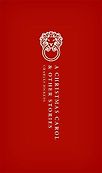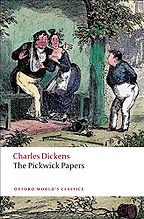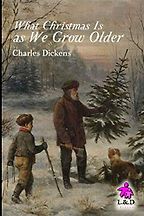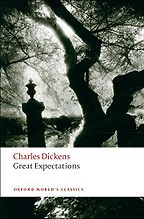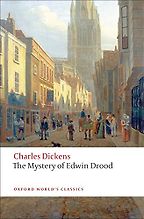Why should we turn to Dickens at Christmastime?
Starting with A Christmas Carol, or perhaps even earlier with the Christmas episode in The Pickwick Papers, Dickens has been seen as someone who not only describes the importance of generosity and kindness, but also exemplifies it in his own writing. He writes in a way which always gives you more of what you want—or more of what you think you want. It’s like a series of presents that never stop coming. In effect, his prose is a little bit like those fairy tales about overflowing pots of porridge, or geese that carry on laying golden eggs.
One of the problems with A Christmas Carol is that it’s seen so much as a period piece now. When you see little images of urchins scampering around in the snow and chestnuts roasting on an open fire, we think of that as being ‘Dickensian’. It’s a kind of invitation to nostalgia, but it’s often a nostalgia for Christmas that never was. Even when Dickens was writing about it, he was deliberately romanticizing and inventing an idealized version of Christmas.
That’s what he says in the essay “What Christmas Is As We Grow Older”, which is one of your five choices. It’s this idea that the Christmas in our minds—the one we’re always hoping for next year—will never come.
In some ways, of course, we all think that. We think of Christmas as an ideal we’re trying to reach. Often that’s a kind of nostalgia, isn’t it? We’re trying to capture a perfect childhood that never was, and often try and produce that for our own children (if we have children). For Dickens, that has a Christian element, of course. It’s about becoming like a little child, which, in his case, means not trying to recapture innocence so much as trying to capture a capacity for surprise and wonder.
A Christmas Carol itself is much weirder than that. The tone of it is very unstable, ghostly, uncanny. It veers between the familiar and the strange all the time. There are some bits of it which are absolutely bog-standard melodrama, and other bits which are domestic farce, and still other bits of it which are fairy tale. It switches tones and registers—genres—all the way through so that as a reader, you’re always kept on the hop. You never quite know what’s coming next. In some ways, that’s true to the story itself: you need to have the familiar made strange in order to appreciate it properly.
During the Victorian period, many Christmas traditions and customs were being re-evaluated. How was Dickens’s Christmas different than ours?
The kind of Christmas that we take for granted is largely a Victorian invention. Especially in the earlier part of the period, many modern Christmas traditions are beginning to develop. They’re bound up, perhaps, with the growing Victorian celebration of the domestic—both the family, and the idea of the family unit as being a little model of togetherness you can set against a potentially hostile outside world.
Carols, Christmas cards, Christmas trees: these are all either cultural imports (like the tree from Germany, which is Prince Albert’s fault—or responsibility) or rediscoveries, such as carols, which of course are much older, but they’d fallen into abeyance for generations. It’s the Victorians who start publishing and celebrating them again.
So we find these new traditions pretty much instantly permeate the literature?
Absolutely. Hence the title A Christmas Carol.
Let’s start with that book, which out of the five is doubtless the one most will be most familiar with. It’s been made, remade and done to death, but somehow is still timeless—why is A Christmas Carol worth revisiting every Christmas?
A Christmas Carol is an unusual story to choose in some ways, because although we associate it so strongly with Dickens, it’s also broken free from Dickens. It began to circulate through culture much more generally. Like a fairy tale, it’s become almost anonymous. That’s because it’s something like a modern myth: like most myths, you can dress it up in lots of different clothes and populate it with different characters. You can modernize it, you can do almost anything with it—the basic story will still remain the same.
It’s ancient and it’s modern; it’s foreign and it’s familiar. It’s also one of the only stories which, even though I know it probably off by heart, I’m still surprised by when I read it. Some bits of it, like the death of Tiny Tim, still make me cry. I did a public reading of it last year, and I did actually break down in tears, in a way which is both kind of sweet and pathetic. But Dickens did too when he did his own public reading. He was also moved by his own pathos.
Are we meant to identify with Scrooge, do you think? Or stand apart from him?
I think both. The narrator’s tone is very interesting, because on the one hand, Scrooge is held up as a character to be mocked and pitied, and on the other hand, his sense of humor—even though it’s quite a bitter sense of humor—is such that we’re also secretly rooting for him all the way through. He’s a hero and an antihero, all bound in one.
What would you say to someone who might see A Christmas Carol as a purely moralistic tale in which an evil man gets his comeuppance and is then converted to moral sympathy?
I’d say Dickens is very good at writing stories which have morals but are not moralistic. It’s an important distinction, I think. The moral seems to be almost incidental rather than the point of the story.
Your second choice is The Pickwick Papers, Dickens’s first novel. For those who haven’t read it, tell us about it.
The Pickwick Papers was published serially, but also episodically: the story, such as it is, hops around in quite unpredictable ways. It’s full of these little in-set stories—episodes which can be detached, like an anthology that’s been scattered through the novel.
“Dickens is very good at writing stories which have morals but are not moralistic”
This particular Christmas episode was published on the 31st of December, 1836. It was written just after a major snowstorm. Dickens wrote it quickly and happily; you can see the atmosphere of the approach of Christmas and a snowy landscape all the way through the episode itself. It’s a world of blazing log fires, punch bowls, friendship, and a return to childhood games. All the things which Dickens would go on later to make central to his other writings about Christmas.
It ends with what is in some ways a version of A Christmas Carol. “The Story of The Goblins Who Stole a Sexton” involves a misanthrope who decides to celebrate Christmas in his own way by digging a grave. He’s tormented by visions of a happy family life which he doesn’t have, and then decides to reform himself. He’s converted to the kind of optimism and generosity Dickens associated with Christmas. It’s a prototype of Scrooge.
I found the heading for the Christmas chapter totally characteristic of Dickens’s wit: “A good-humoured Christmas chapter, containing an account of a wedding, and some other sports beside, which altogether in their way, even as good customs as marriage itself, are not quite so religiously kept up, in these degenerate times.” Is that how Dickens saw himself—an author imparting good humor in degenerate times?
One of the big distinctions that’s made in the Victorian period, which Dickens knew, is between ‘wit’ and ‘humor’. Wit is cleverness, often at someone else’s expense, whereas humor he sees as being generous and all-inclusive. For Dickens, Christmas is a time for humor. So it’s a “good-humoured” chapter in the sense that it’s not only funny, but it’s also designed to bring people together. It’s a kind of virtual version of the fire that he ends up talking about.
It was published serially. Was it more likely to be read aloud by the hearth, or by individuals silently, say, on the train?
Well, both. We have records of people doing both. The fact that Dickens ended up taking Christmas as one of his public readings—his version of A Christmas Carol—suggests that what he wanted was to treat his readership as a kind of extended family, who’d gather together around him as if around a virtual fire. He’s the storyteller who is drawing them in, but also drawing them together.
Your next choice, an essay called “What Christmas Is As We Grow Older” published at Christmastime in 1851, conjures an image of this virtual hearth: “Welcome, alike what has been, and what never was, and what we hope may be, to your shelter underneath the holly, to your places round the Christmas fire, where what is sits open-hearted.” Should we pay attention to the editorial ‘we’ here?
Dickens hopes that the editorial ‘we’ is going to be a little model of inclusiveness. The readers become part of that ‘we’, as if he’s trying to conjure an atmosphere of tolerance, generosity and inclusiveness in his writing, as well as write about it. He’s trying to write it into existence. Which is a classically Dickensian mode—you don’t just talk about something; you try and make it happen in your writing. Or through your writing.
It’s a story in which he reflects on what he says is what has been, and what never was, and what we hope may be. It’s because he sees Christmas as a time for reflection, for thinking about the passage of time. For Dickens, Christmas is a time for not only measuring how things have changed (and how they remain unchanged), but also showing that you can redirect the paths of your life in a different direction, should you choose. That’s because for Dickens, Christmas isn’t just a day—it’s a state of mind. It’s a state of mind that encourages those thoughts of generosity and inclusiveness.
“For Dickens, Christmas isn’t just a day—it’s a state of mind”
What’s interesting about his writing is that his style when he comes to describe Christmas often tries to mimic everything he celebrates. For instance, the syntax becomes longer. The lists become more tightly packed with ingredients. It’s as if he’s trying to squeeze more and more into the writing. It’s as if generosity is something that he wants to somehow embody in prose.
In A Christmas Carol, Dickens realizes that, to an extent, you can laugh at these things as well as take them seriously. Later on, it’s if he becomes more earnest, more nervous about everything. As the writing becomes darker in the novels, the essays and shorter pieces have to be more straightforwardly singular in their tone, as if they’re holidays from the darker novels. But that also means that there’s less blurring—less blending of those tones—than you get elsewhere.
Is this essay in particular written in a transitional stage for Dickens? We’ve had the Christmas tales of the 1840s; we’re not quite yet into the 1850s and 60s.
It’s right at the end of 1851, after the Great Exhibition, of which Dickens was deeply suspicious. He thought that it gave an entirely false sense of optimism and progress compared to the reality of poverty and social division. And of course the novel that he is just starting to write—which he’ll start publishing a couple months later—is Bleak House.
Five Books interviews are expensive to produce. If you're enjoying this interview, please support us by donating a small amount.
Bleak House is a way of exposing all those social divisions that other people thought that the Great Exhibition had nicely covered up. So in some ways, you could see it as a transitional work, not only between the earlier cheerful, chirpy Christmas stories and what’s going to become much darker version of Christmas, The Mystery of Edwin Drood, but it’s also in some ways transitional as he moves towards what are sometimes called the ‘darker novels’, beginning with Bleak House and moving on from there.
We see a flicker of darkness in this essay, too. Toward the end I was surprised by Dickens suggesting that the “we” of the story—that is, all of us, Dickens and his readers—turn our faces from the fire “towards that City”, the “City of the Dead.” This seems almost religious and mystical. What does he mean by this mournful imagery, and what’s the place of an ode to the dead in a piece about Christmas?
It’s probably worth saying that he had lost one of his own children, Dora, named after the one of the characters in David Copperfield. She had died very young, earlier in 1851. So talking about dead children in this essay was obviously very personal. He’d also lost his father—his father, of course, having been a hugely important presence in Dickens’s life as a child, not least because he’d lost part of his own childhood to poverty and unhappiness.
When Dickens writes about lost children, he’s not only thinking about death as a single event. It’s also that death is a process you can go through as a child where your sense of childhood optimism and hopefulness can be slowly obliterated through the grind of poverty and family misery.
Grief is a state of mind, just like Christmas.
Absolutely. Dickens often thought of his own childhood as being lost. In some ways, you might think of the novel’s attempt to not just recapture or reimagine, but to invent, a childhood for himself he never had.
Do you think that might be part of the reason why he returns to Christmas so often, like an essential key? Is it because it allows him to be a child again?
It’s a time when everyone can be a child. But it’s a means for recapturing an idealized version of a childhood you might never have experienced in life. For somebody who had such an intermittently unhappy childhood as Dickens, that’s its huge importance.
Next, we move deep into Dickens’s career with his thirteenth and penultimate completed novel, Great Expectations (1860-61). The book opens on Christmas Eve around 1812, with pip encountering an escaped convict. What happens next?
It’s not a ghost story, but there are hints of the ghostly—the dead not wanting to stay dead.
We have glimpses of that when Pip is walking through the churchyard, and he imagines the dead reaching up out of their graves and trying to get a hold of his ankles to pull him down. Only when we get the right to the end of the novel—spoiler alert—do we realize it’s because Magwitch, the person he meets in the graveyard, is in fact dead. He’s been dead all the way through the novel. So in some ways it is a ghost story, because Pip is still haunted as an adult by that vision that he saw as a child.
It’s also a strange parody of the more optimistic stories in which people exercise generosity and benevolence, even upon strangers. Because what Pip does is go to his home and steal some food to bring it to the churchyard to give to the escaped convict. It’s a little bit like leaving a mince pie out for Santa: it’s that strange sense that by giving a little something to someone, there’s the possibility that you might get repaid later.
Indeed, Pip is repaid many, many times over. It just so happens that rather than getting Christmas presents, Magwitch turns out to be the kind of Santa Claus who gives presents all the way through the rest of Pip’s life, in terms of money and influence. What the rest of Great Expectations shows is that having Christmas last all the way through your life might not be a good thing. Having a Santa Claus who keeps throwing gifts and money at you when they’re not necessarily wanted or deserved might be a handicap.
So, making Christmas ghostly and uncanny is Dickens signalling to the reader that it’s not just cheery domestic realism?
That’s right. Pip’s own family life is deeply miserable. For him, it’s not as if Christmas is a holiday from the grind of domestic misery. It’s more like an intensification of it. That’s why Magwitch provides, ironically, a kind of escape for Pip, as well. It’s an opportunity to meet someone who’s part of a very different world. The point of the novel is to bring those worlds together and make you realize they’re not two different coins; they’re two sides of the same coin.
Last, we have The Mystery of Edwin Drood (1870), Dickens’s final novel. Why did you choose this one?
This is some ways the evil twin of A Christmas Carol. If A Christmas Carol is about somebody discovering previously hidden reserves of happiness and family feeling, and going off to celebrate Christmas with his nephew, The Mystery of Edwin Drood is about someone discovering previously unknown reserves of unhappiness and fury on Christmas Eve, and probably killing his nephew. It’s a mirror reverse of his most famous Christmas story.
It also takes some of the ingredients of A Christmas Carol and warps them. In A Christmas Carol, Scrooge has visions of three spirits; in The Mystery of Edwin Drood, Jasper, who is the anti-hero and probably the murderer, also has visions, probably caused by opium. He too finds it hard to tell what is real and what is not real—which, in some ways, is the dream of fiction, isn’t it? To not really know the difference between what is real and not real.
But it’s also for him a kind of nightmare, because it means that he can no longer be sure what he’s done and what he’s not done. If Christmas is a time where the normal rules of life are suspended, then in some ways an opium dream is like a kind of chemically-induced version of Christmas. The ordinary rules of life no longer seem to apply.
What Dickens seems to be interested in here, as in Great Expectations, is realizing that Christmas isn’t only a time for family and friendship and roasting chestnuts on an open fire. It’s also potentially a time where tensions, unhappinesses and uncertainties can become concentrated. It’s a little like an EastEnders Christmas special. All the things that have been floating around in the rest of the year come to a point.
Social ills as well as domestic.
Absolutely. Ignorance and Want, the two children Scrooge meets in A Christmas Carol, in some ways are allegorical versions of Dickens’s own anxieties, laced throughout his entire career.
It’s also that ignorance and want aren’t only things that children suffer from: adults, too, want things, and are ignorant where they shouldn’t be. Dickens is all too aware of that.
What are Dickens’s great lessons about Christmas? It seems from A Christmas Carol, one is generosity and a heightened attention to poverty.
A heightened attention to a bit of the world our eyes normally gloss over. That includes poverty, but it also includes the people around us we take for granted. That might begin with family, but it shouldn’t end with family. I suspect Dickens knew that Christmas then was a way of concentrating our attention on not so much trying to draw morals, as trying to encourage us to look at the world as a novelist might look at it. In other words, with attention to detail.
To make it strange and familiar at the same time.
That’s exactly right.
Five Books aims to keep its book recommendations and interviews up to date. If you are the interviewee and would like to update your choice of books (or even just what you say about them) please email us at [email protected]

